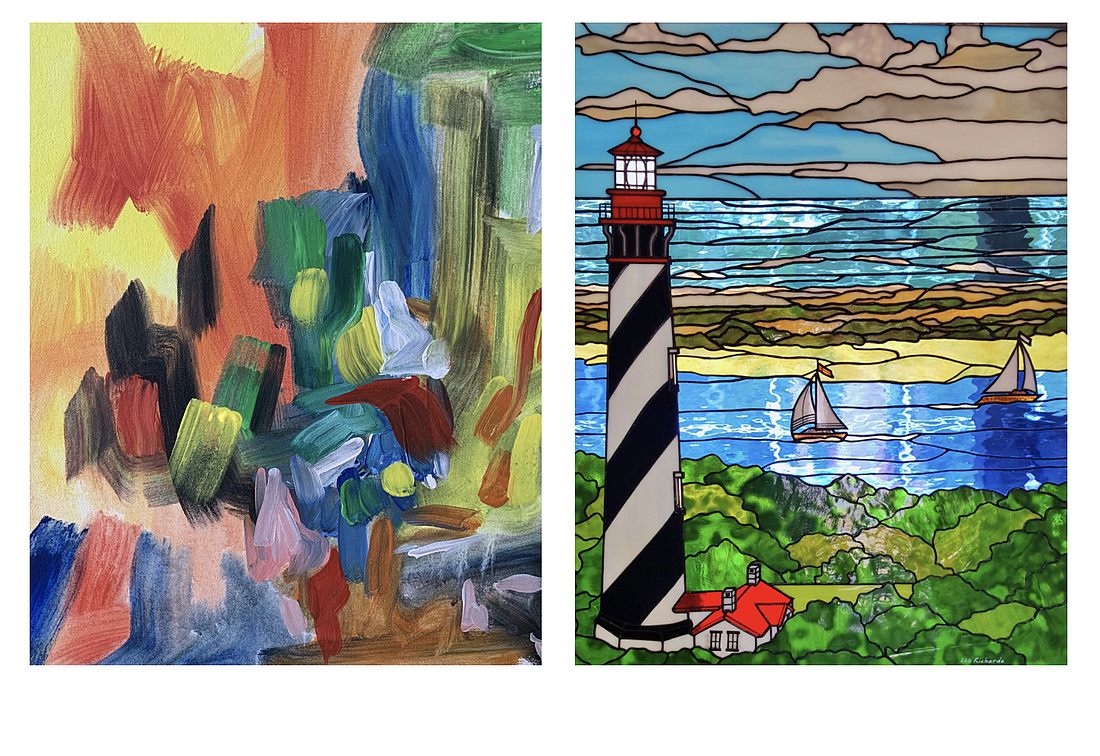- April 24, 2024
-
-
Loading

Loading

The artwork of Lee Richards and Dex Westphal could not be more dissimilar.
The two Flagler County artists present quite a contrast as they share an art show entitled “Singing Colors” at the Grand Gallery of Palm Coast Arts Foundation at Grand Living Realty, 2298 Colbert Lane, Palm Coast.
The show opened March 7 and will continue through April 17. The Grand Gallery is open Mondays through Saturdays, 9 a.m. to 5 p.m. and although it is normally closed on Sundays, an opening reception with the artists is scheduled for 1-3 p.m. Sunday, March 14. Admission is free, and masks are required for the reception and all of the show dates.
Richards is a stained glass artist. Every cut he makes must be precise. Westphal is an abstract acrylic artist and refers to herself as an intuitive painter. She begins her paintings “with no plan at all. In fact, I’m as surprised as anybody else when it’s done,” she said.
Both artists have won multiple awards. Richards was the Gargiulo Art Foundation 2019 Artist of the Year, which was presented last year. Westphal was a 2018 GAF Artist of the Year nominee.
The show is the first since the Grand Gallery has come under the wing of the Palm Coast Arts Foundation.
“The association will make the gallery more of a presence in the area,” said Jan Jackson, the Grand Gallery’s curator. “It will definitely get more promotion, and that’s a good thing for artists in the area during this shutdown period.”
Here’s a look at the artists:
Richards is the public works project manager for the city of Flagler Beach. He has a PhD in engineering management and a master’s degree in architecture. He began working with stained glass 45 years ago when he took an adult education class.
“I fell in love with it after the first lesson,” he said. “We did some simple patterns. I just was bored with the simple patterns. I wanted to move right in with advanced stuff, so I did a Tiffany lamp, and I did some parrots. I got progressively better and better over the years.”
And his pieces have gotten progressively more complex. His “Peacock” contains 1,200 pieces of stained glass. Each eyespot on the peacock’s tail feathers is made up of nine separately cut pieces of glass.
“Those pieces were really tough to cut, but I’ve developed some techniques over the years that enabled me to do much more complex things than that,” he said.
One of his pieces will be highlighted in the next issue of Stained Glass Quarterly. He has 16 pieces in in the Singing Colors show, including three light boxes, which look like framed stained glass artworks hanging on a wall.
“It has an LED flat panel inside of it, so you get the advantage of hanging it on the wall, yet seeing it as if it had a full spectrum of light coming through it. It’s really a fantastic effect,” Richards said.
He has another light box piece that is currently in a national show in Kokomo, Indiana. Between setting up his works for the Palm Coast show and working full time, Richards is also working on a commission to produce a stained glass piece for a front door and sidelight of a surfer riding a wave.
“It probably has about 700 and some pieces,” he said. “I’ve designed it so the wave flows from the door over to the sidelight.”
Each of his pieces takes him up to six months to complete. "The Peacock" took him nine months. He begins with a sketch, then cutting and oiling the glass, soldering it all together and cleaning it. He touches each individual piece of glass up to 10 times during the process.
“My work is very, very different from anything you’ve imagined stained glass to be,” he said.
Westphal, 81, doesn’t plan her paintings or even her schedule. Intuitive painting means you don’t go into the studio “until something builds up inside you and you have to run in there and do it,” she said.
Sometimes that’s at 3 a.m. when it’s nice and quiet. Her beloved goat hair brushes from China dance around the canvas. She even has one painting called “Dancing Brush.” She has a porcelain palette, also from China, and her brush dances around the palette and the canvas from color to color.
“When I go in I have no preconceived idea of what’s going to happen,” she said. “The rules are no correcting or going back. Whatever happens, happens.”
“Some of these can be done very quickly,” she said. “Some can take a long time, oh, maybe a week. The fastest one I ever did, I started up the coffee maker, went into the studio and the painting was done before the coffee.”
She also paints with dowels to produce artwork in the style of Australian Aboriginal dot paintings.
“Even with the dowel paintings, I never know what’s going to happen, how it’s going to turn out,” she said. “They’re done on very large canvases, 3 feet by 4 feet. The dowels are quite small, so it takes a long time to get one of those put together.”
Westphal said she was originally trained to be a very traditional oil painter. She was taught to paint still lifes in exact proportion matching the colors precisely. She evolved into her intuitive style only in the past 10 years.
She taught art for 10 years at the Community College at Baltimore County and continued teaching after moving to Palm Coast eight years ago.
“I’ve taught all different ages, but my favorites were the 3-year-olds and the senior citizens,” she said.
She has 33 paintings in the Singing Colors show ranging in size from 8-by-8 inches to 3-by-4 feet and ranging in price from $150 to $1,500.